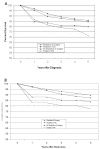Malignant pineal germ-cell tumors: an analysis of cases from three tumor registries
- PMID: 18287340
- PMCID: PMC2613814
- DOI: 10.1215/15228517-2007-054
Malignant pineal germ-cell tumors: an analysis of cases from three tumor registries
Abstract
The exact incidence of pineal germ-cell tumors is largely unknown. The tumors are rare, and the number of patients with these tumors, as reported in clinical series, has been limited. The goal of this study was to describe pineal germ-cell tumors in a large number of patients, using data from available brain tumor databases. Three different databases were used: Surveillance, Epidemiology, and End Results (SEER) database (1973-2001); Central Brain Tumor Registry of the United States (CBTRUS; 1997-2001); and National Cancer Data Base (NCDB; 1985-2003). Tumors were identified using the International Classification of Diseases for Oncology, third edition (ICD-O-3), site code C75.3, and categorized according to histology codes 9060-9085. Data were analyzed using SAS/STAT release 8.2, SEER*Stat version 5.2, and SPSS version 13.0 software. A total of 1,467 cases of malignant pineal germ-cell tumors were identified: 1,159 from NCDB, 196 from SEER, and 112 from CBTRUS. All three databases showed a male predominance for pineal germ-cell tumors (>90%), and >72% of patients were Caucasian. The peak number of cases occurred in the 10- to 14-year age group in the CBTRUS data and in the 15- to 19-year age group in the SEER and NCDB data, and declined significantly thereafter. The majority of tumors (73%-86%) were germinomas, and patients with germinomas had the highest survival rate (>79% at 5 years). Most patients were treated with surgical resection and radiation therapy or with radiation therapy alone. The number of patients included in this study exceeds that of any study published to date. The proportions of malignant pineal germ-cell tumors and intracranial germ-cell tumors are in range with previous studies. Survival rates for malignant pineal germ-cell tumors are lower than results from recent treatment trials for intracranial germ-cell tumors, and patients that received radiation therapy in the treatment plan either with surgery or alone survived the longest.
Figures



References
-
- Hoffman HJ, Otsubo H, Hendrick EB, et al. Intracranial germ-cell tumors in children. J Neurosurg. 1991;74:545–551. - PubMed
-
- Drummond KJ, Rosenfeld JV. Pineal region tumours in childhood. A 30-year experience. Childs Nerv Syst. 1999;15:119–127. - PubMed
-
- CBTRUS. Statistical Report: Primary Brain Tumors in the United States, 1998–2002. Central Brain Tumor Registry of the United States; 2005.
-
- Matsutani M, Sano K, Takakura K, et al. Primary intracranial germ cell tumors: a clinical analysis of 153 histologically verified cases. J Neurosurg. 1997;86:446–455. - PubMed
-
- Jennings MT, Gelman R, Hochberg F. Intracranial germ-cell tumors: natural history and pathogenesis. J Neurosurg. 1985;63:155–167. - PubMed
Publication types
MeSH terms
LinkOut - more resources
Full Text Sources

